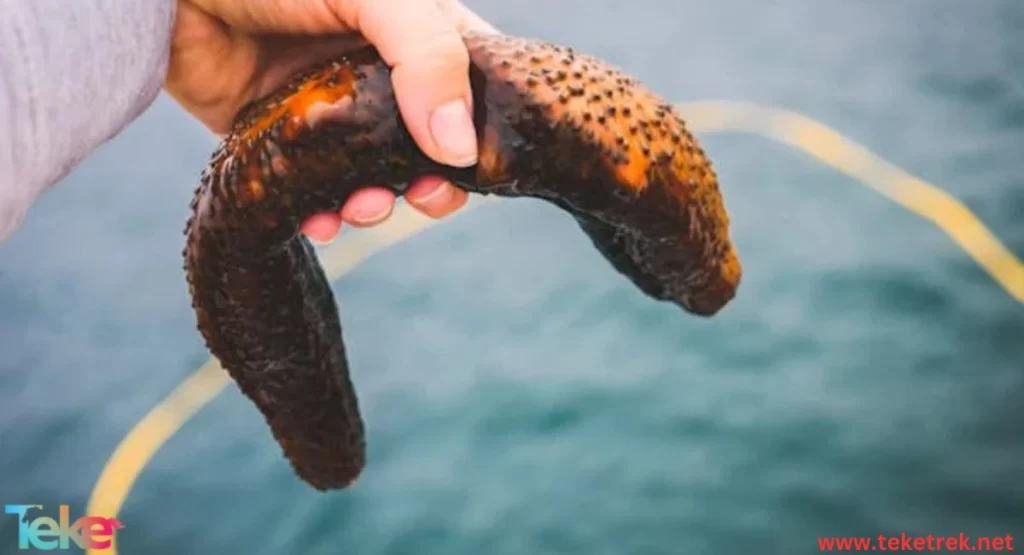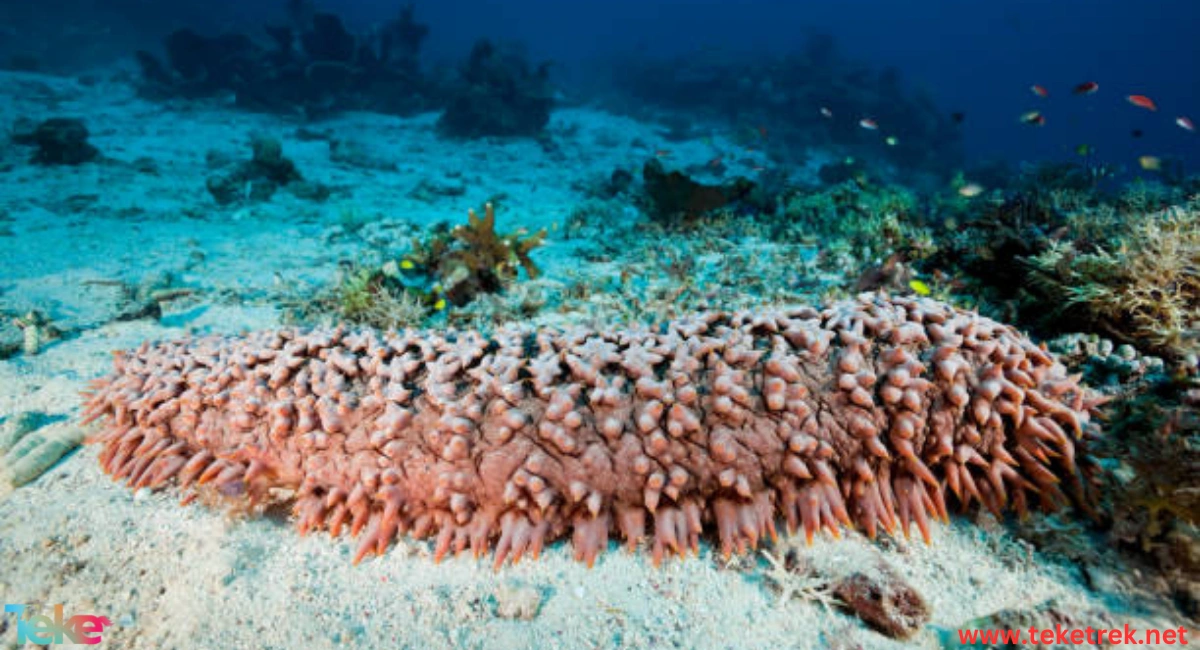Sea cucumber is one of the secrets of the sea, a beautiful looking creature full of benefits like a
cucumber.
Below on the Tiki Trick website, we talk in more detail about this terrible creature. We will present its characteristics and benefits, how it feeds and reproduces, and the most important amazing facts about it.

About sea cucumber
It is one of the types of marine animals. Sea cucumbers are classified as invertebrates, as they belong to the group of echinoderms called Echinoderms. Its name comes from the fact that it resembles a cucumber and is classified within the kingdom of multicellular animals and the category of sea cucumbers.
It moves on the ocean floor in search of food and communicates through certain signals.
The sea cucumber is characterized by making its body look like liquid when enemies approach it.
Sea cucumber specifications
the body:
The sea cucumber is long and tubular in shape, and it feeds on organic molecules suspended in the water using its coiling arms.
Sea cucumbers are elongated creatures with soft skin, on which the reproductive glands protrude, resembling rows of spines or appendages.
In addition to the presence of a number of branched tentacles surrounding the mouth.
the color:
Sea cucumbers are distinguished by their many colors, as they can be black, brown, or green.
Sea cucumber size
The length of sea cucumbers ranges from 3 cm up to a meter. It has five rows of tube feet that begin with the mouth and end with the anus.
Internal organs:
The sea cucumber is distinguished by its ability to expel its internal organs through the anus in order for new organs to grow.
antennae:
Sea cucumbers have unusual antennae that function like hands, as they lengthen and shorten to catch food and bring it to the mouth
The most important nutritional values and benefits of sea cucumber:
Sea cucumber has many nutritional values and health benefits, including:
1. Proteins: Sea cucumber contains a high percentage of proteins, making it an excellent choice for meeting your daily protein needs.
It also supports joint health, due to its richness in some important joint compounds.
2. Vitamins and minerals: It contains vitamins such as vitamin A, C, E and K, and minerals such as calcium, magnesium, potassium and iron, which help support bone health, the immune system, eyesight and skin.
Sea cucumber also contains important compounds that are beneficial for cancer and natural anti-inflammatory compounds.
3. Dietary fiber: Sea cucumber contains a good amount of dietary fiber, which enhances the health of the digestive system and helps improve the digestion process and make you feel full.
4. Omega-3 fatty acids: Sea cucumber contains a moderate percentage of omega-3 fatty acids, which are beneficial for cardiovascular health and reducing the risk of heart disease. It also helps promote liver health and reduce wrinkles.
5. Low in calories: Sea cucumber is low in calories, making it a suitable choice for those seeking to maintain a healthy weight.
To sum up, sea cucumbers are a nutritious and healthy addition to any diet, and can be used in a variety of ways in meals to take advantage of their many nutritional benefits.
Sea cucumber species
There are approximately more than 1,200 species of sea cucumber in nature, the most important of which are:
The Japanese sea cucumber:
It is a large animal characterized by having around 20 tentacles surrounding its mouth. It is found in three colors: red, black, and green, and it inhabits the Sea of Japan..
Brown sea cucumber:
This species is characterized by its orange, yellow, or brown colors and has dark feet with pointed tips emerging from the bottom. If it is in danger, it releases sticky white cylindrical tubes.
Red sea cucumber:
It has a smooth, cylindrical body that is yellowish-red in color. It has a bony skeleton located directly under the skin, and if it is exposed to danger, it releases all the contents of its stomach through the anus.
Atlantic sea cucumber:
It is often found in the depths of the ocean in Canada in cool, clean waters. This type is suitable for human consumption, as it has a high nutritional value and contains a small percentage of fat.
Chinese sea cucumber:
It is very popular in China because of the great benefits it contains, which has made people grow it.
What do sea cucumbers eat?
The sea cucumber relies on itself to search for its food. It is a carnivore and also prefers to eat plants.
It feeds on algae and phytoplankton, as well as some small organisms. It can also eat some of the waste found at the bottom of the sea.
The presence of tentacles around its mouth helps it eat its food, where it captures food and turns it into small particles.
Where are sea cucumbers found?
Sea cucumbers prefer to live in the oceans of all oceans of the world, where they are found in the Indian, Atlantic, and Pacific oceans.
We can also see it in shallow and coastal waters and in deep places at the bottom of seas and oceans.
Sea cucumbers can be found among seaweeds, where they hide themselves in the sand during the day to be active at night.
Sea cucumber reproduction
Fertilization in sea cucumbers occurs in the sea, where the female pushes the eggs into the water, and these eggs contain a substance that greatly excites the males and makes them release sperm for fertilization to occur.
After the fertilization process, the larvae emerge into the water and are small, tossed around by the waves until they grow and become adult animals.
Young sea cucumbers grow slowly and become sexually mature after about five years of age.
10 Facts About sea cucumbers
· Although they are members of the echinoderms, sea cucumber echinoderms are small teleosts embedded in the skin
· Sea cucumbers move very slowly despite having five rows of feet.
· These animals breathe through the anus, by drawing oxygenated water through the anus. Water goes into the respiratory tree and transports oxygen to the fluids within the body cavity.
· Some sea cucumber species bury themselves completely in sediment.
· Some species of sea cucumber ingest sediment, remove food particles, and then excrete the sediment in long threads.
· The outer wall of the sea cucumber’s body is made up of collagen, and this substance, of course, gives it the opportunity to make its body larger and looser whenever it wants.
· The sea cucumber collects all the lost organs and viscera, collecting them in a period of up to 1 to 5 weeks.
· Sea cucumbers have other defenses, such as the hooks on their skeleton, which make them more difficult to eat by predators.
· Sea cucumbers can send signals through the water that rely entirely on hormones as a means of camouflage from predators.
· Sea cucumbers are nocturnal creatures and are entirely active at night.

FAQs about sea cucumbers
· How do sea cucumbers protect themselves?
· Studies indicate that this simple organism is able to feed on organic waste in the water and remove small particles of organic matter that can disturb the purity of the water. The sea cucumber performs this process by absorbing particles inside itself and using them as a food source, then excreting the waste, which is sand
What did sea cucumber taste like?
Sea cucumber has a very mild and neutral flavor, making it rather bland on its own. However, it readily absorbs the flavors of the other ingredients it is cooked with..
Why is the search option with this name?
For different reasons but in terms of shape and texture they live in the sea.
Why are sea cucumbers banned?
Blocked option for reason industrial use for reason like that.
In short, sea cucumbers reflect the diversity of marine life and highlight the importance of understanding and adapting to the environment. It can be said that it is a marine organism with tremendous nutritional values and many health benefits.
Refrences





